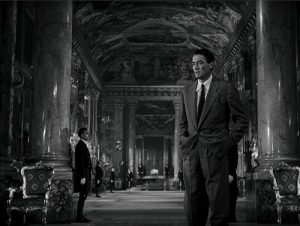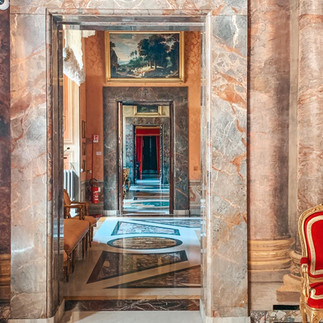Palazzo Brancaccio and Palazzo Colonna: two stunning (and less known) movie locations in Rome
- Apr 24, 2022
- 4 min read
Updated: Jul 13, 2023
Speaking about Roman Holiday movie locations, there are two places you can't miss if you want to follow the footprints of Audrey Hepburn: Palazzo Brancaccio and Palazzo Colonna.
Palazzo Brancaccio: a roman building with "American roots"

Palazzo Brancaccio is the last palace of the Roman particiate, built in 1880. A unique residence in elegant Baroque style born thanks to American inheritance: it was commissioned by Prince Salvatore Brancaccio and his wife Elizabeth Hickson Field, Margherita di Savoia's lady-in-waiting and a rich New York heiress who brought 1 million dollars as a dowry. The noblewoman had purchased it from the Municipality of Rome in 1879; the church, the convent, the vegetable garden and also the garden of the Franciscan Poor Clares of "Santa Maria della Purificazione", assets assigned to the municipal state property following the suppression of religious congregations after the Unification of Italy. These properties also comprehend the Tower of Maecenas, the same tower from which, according to the legend, Nero in the summer of 64 AD, allegedly observed in ecstasy the fire of Rome which he himself had started.
The residence also hides tunnels and underground corridors that lead to Castel Sant’Angelo and San Pietro, and many other legends and secrets.

The residence facade contrasts with the sumptuous interiors, which strike the visitor for the richness of the details. The effect was certainly desired and the search for ostentatious opulence was dictated at the time by the desire to express one's economic wealth, lineage, as well as personal good taste in the choice of furnishings.
The frescoed ceilings were made by Francesco Gai, academician of San Luca and family portrait painter. The interiors of the Palazzo are a Baroque triumph of mirrors, carmine red velvets and stuccoes. The Gala Hall is famous, with a balcony that runs along the perimeter of the room and fourteen-meter high ceilings finely decorated with stuccos and cherubs. But the Palace's real jewel is the splendid Gallery of Mirrors: a room decorated on both sides by mirrored and gilded walls, a glorious and sumptuous homage to the Palace of Versailles. To understand why the production chose this palace for the movie, you just have to look at the pictures.
In the movie, you can see the palace in various scenes: at the beginning when Princess Ann makes her entrance in the presence of other nobles, the throne room, the ballroom, the princess room and the balcony where she runs away from her duties.

Palazzo Brancaccio today is a luxury wedding and party location and can only be visited by booking a guided tour by writing to: palazzobrancaccio@palazzobrancaccio.com
Palazzo Colonna and Galleria Colonna: gorgeous places you can't miss
Skip up at the end of the movie, when Princess Ann goes back to her royal life and decides to meet the press for the last time in Rome: the amazing location you see in this scene is Galleria Colonna.
Curiosity: there is a cannonball on the small staircase in the gallery that was fired from the Janiculum by the French army (when Napoleon conquered Rome); it is there because that's the very same spot where it stopped its course back then. It was momentarily removed during the shooting of the movie and then put back. ⠀

One of the most sumptuous and impressive private palaces in Rome - where the Colonna Family still live - it was built on ancient and medieval foundations over the course of five centuries, and it stands on the remains of Serapis' temple, it is a hymn to the splendor and history of the Colonna family (especially the most famous member of the family Marco Antonio Colonna who won the battle of Lepanto), one of the oldest Roman patrician families. ⠀
The life and fate of men of arms, art and faith intertwined in this palace, creates a combination that has made Palazzo Colonna a unicum of history, art and culture from the Thirteenth century to the present day.
The guided tour (my extraordinary guide was Sara Pietrantoni of 365giorni a Roma, I strongly recommend booking her for a tour) will take you to visit the most beautiful and prestigious apartments of the palace to listen to their history and stories and admire the art and decorations of which they are rich. Then you'll walk through the splendid gardens to find a striking view over Rome.
Finally, there is the Gallery, the real wonder of the entire tour itinerary. An authentic jewel of Roman Baroque, it was commissioned in the mid-1600s by Cardinal Girolamo I Colonna and his nephew Lorenzo, and it was conceived as a large reception room to worthily celebrate the victory of the Christian fleet over the Turks at the Battle of Lepanto in 1571.
I can't forget how astonished I felt when I entered the Gallery: the light, the marble, the artworks... everything is a piece of the perfect puzzle that creates one of the most beautiful things I have ever seen in my life.

Walking through the monumental space of the "Sala Grande" you can admire the frescoes on the ceiling, representative of Marcantonio II Colonna and the Battle of Lepanto. On the walls, you can admire painted mirrors with vases of flowers and cherubs, ancient statues, monumental wall tables, paintings of the Sixteenth and Seventeenth centuries, including Adam and Eve by Francesco Salviati, Saint Francis in prayer by Guido Reni, Saint Paul the hermit of Guercino, Saint John the Baptist in a cave by Salvator Rosa. At the end of the Gallery is the "Sala dei Paesaggi", which takes its name from the numerous views on the walls, with frescoes depicting the Glory of Marcantonio II on the vault. Two beautiful and sumptuous caskets are exhibited here, one in ebony and ivory, the other in sandalwood and semi-precious stones.

The visit lasts about 2 hours and a half.
Visit the official site for the opening days and how to book a tour.

























Comments